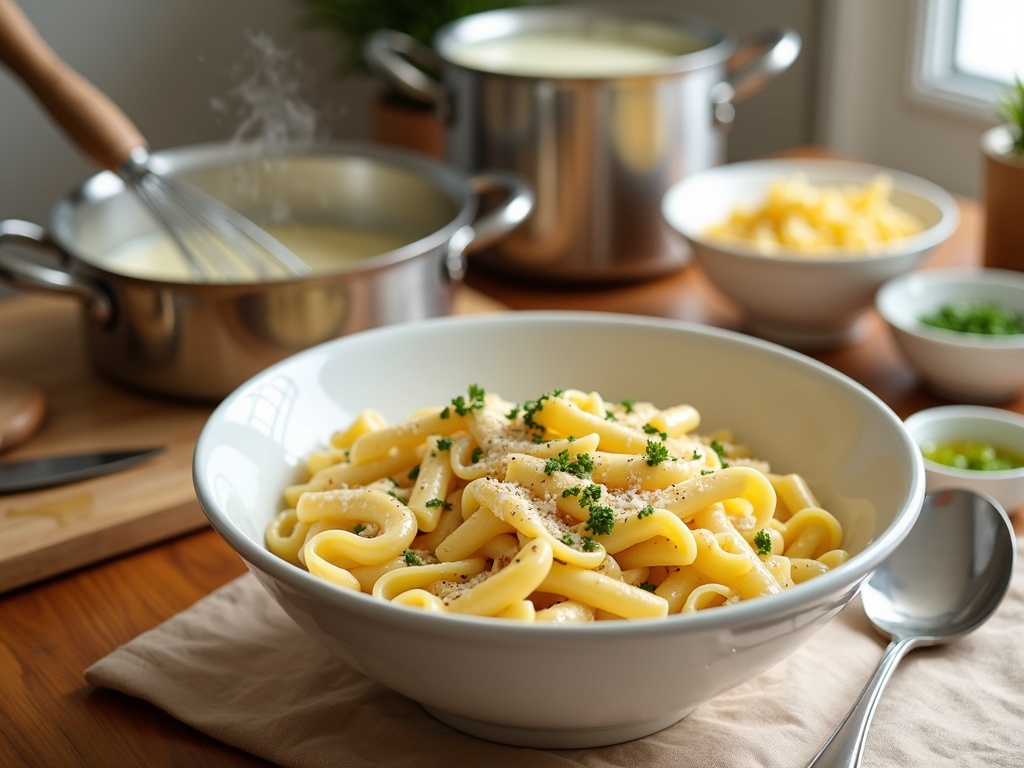White sauce pasta recipe combines the rich creaminess of béchamel sauce with perfectly cooked pasta to create a comforting Italian classic. It works beautifully as a standalone dish or as a base for adding other ingredients. The silky texture comes from mastering the roux technique, using freshly grated cheese, and knowing how to properly combine sauce with pasta for restaurant-quality results.
Find In This Article
Key Takeaways
- Use room temperature milk and continuous whisking to create a smooth, lump-free white sauce with proper consistency.
- Cook the roux for 2–3 minutes to eliminate raw flour taste and develop a nutty flavor foundation.
- Choose the right pasta shape like penne, fettuccine, or farfalle that will effectively hold the creamy sauce.
- Always reserve some starchy pasta water to adjust sauce consistency and help it cling better to the pasta.
- Store leftovers in airtight containers for up to 4 days and reheat gently with a splash of milk to restore the original creamy texture.
Required Kitchen Tools You’ll Need
Creating a delicious white sauce pasta dish starts with having the right tools at hand. I’ve found that proper equipment makes all the difference between a lumpy sauce disaster and silky smooth perfection. Let’s look at the essential kitchen tools you’ll need before diving into your pasta creation.
Essential Tools for White Sauce Success
A large pot is non-negotiable for cooking pasta properly. You need enough water for the pasta to move freely as it cooks, preventing sticking and ensuring even cooking. The pot should be big enough to hold at least 4-6 quarts of water, giving your pasta plenty of room to dance.
For the white sauce (béchamel), a medium-sized heavy-bottomed saucepan works best. The heavy bottom distributes heat evenly and prevents scorching, which is crucial when working with milk and flour. I prefer a 2-3 quart saucepan with tall sides to contain any splatter when whisking.
Speaking of whisking, a good quality whisk is absolutely essential for traditional Italian sauce preparation. This tool helps incorporate the flour into the butter and breaks up any lumps in your sauce. A balloon whisk with thin wires works particularly well for white sauce.
Here are the remaining must-have tools:
- Measuring cups and spoons for precise ingredient portions (both dry and liquid measures)
- Colander for draining cooked pasta without losing any down the sink
- Wooden spoon for stirring pasta and gently folding sauce and pasta together
- Sharp knife for any additional ingredients like garlic or herbs
- Cutting board for prep work
I always recommend keeping a ladle or serving spoon nearby for the final plating. Remember that pasta dishes often need a splash of pasta water to achieve the perfect consistency, so keep a cup handy before draining your pasta.
Having these tools ready before you start cooking streamlines the entire process and helps ensure your white sauce pasta turns out perfectly every time.
Essential Ingredients for Perfect White Sauce Pasta Recipe
The foundation of an irresistible white sauce pasta begins with selecting the right ingredients. I’ve found that using high-quality components makes all the difference between an ordinary pasta dish and something truly special.
The Base Components
For the pasta itself, 1 pound of penne or fettuccine works perfectly for holding the creamy sauce. Penne’s tubular shape captures pockets of sauce inside, while fettuccine’s flat surface allows the sauce to cling beautifully. I always cook the pasta just until al dente since it will continue cooking slightly when mixed with the hot sauce.
The white sauce (béchamel) starts with a simple roux made from 4 tablespoons each of butter and all-purpose flour. This combination creates the thickening agent that gives the sauce its body. Make sure to use unsalted butter so you can control the saltiness of your final dish.
For the liquid components, you’ll need:
- 3 cups whole milk
- 1 cup heavy cream
This combination strikes the perfect balance between richness and lightness. The whole milk provides a good base, while the heavy cream adds that luxurious silkiness that makes the sauce truly special. I don’t recommend substituting with lower-fat alternatives as they won’t produce the same velvety texture.
Flavor Enhancers
The aromatics and seasonings transform a basic white sauce into something memorable. Two cloves of minced garlic add a subtle depth that complements the creaminess without overpowering it. I like to sauté the garlic in the butter briefly before adding the flour to develop its flavor.
For cheese, 1 cup of freshly grated Parmesan is non-negotiable. Pre-grated versions often contain anti-caking agents that can make your sauce grainy. Freshly grated Parmesan melts beautifully and brings that distinctive nutty, salty quality that’s essential to a good Italian pasta dish.
Salt and freshly ground black pepper are crucial for seasoning. I season in layers:
- A pinch of salt in the pasta water
- A bit in the sauce as it cooks
- Taste and adjust at the end
Black pepper adds a subtle heat that cuts through the richness.
Finally, fresh parsley for garnish adds a pop of color and a fresh, herbaceous note that balances the richness of the sauce. Chop it finely and sprinkle it just before serving for maximum impact.
For an elevated version, you can add:
- Grilled chicken
- Sautéed mushrooms
- Steamed broccoli
These additions turn the dish into a complete meal while complementing the delicate flavors of the pasta side dish.
The beauty of white sauce pasta lies in its versatility. Once you’ve mastered the basic sauce, you can customize it with different herbs, cheeses, or add-ins. Try mixing in some homemade pesto for a flavor twist, or fold in some roasted garlic instead of fresh for a deeper, more mellow flavor profile.
Remember that the quality of each ingredient matters in a dish with so few components. Using fresh, high-quality ingredients will take your white sauce pasta from good to unforgettable. The difference between store-brand and premium Parmesan cheese or between UHT and fresh cream is immediately noticeable in the final dish.
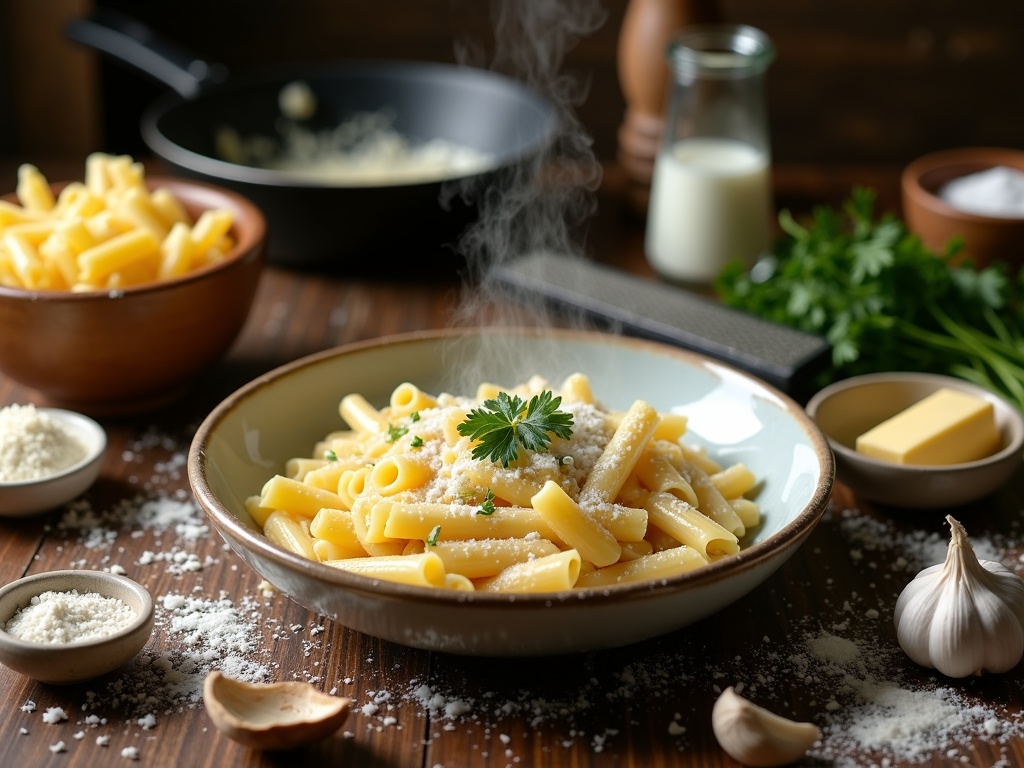
Creating Your Creamy White Sauce
The magic of white sauce pasta lies in perfecting that silky, creamy sauce that coats each strand of pasta. I’ve found that taking your time with this crucial component pays off with incredible flavor.
Building Your Sauce Base
I start by melting butter in a medium saucepan over medium heat. This creates the rich foundation for the sauce. Once the butter is completely melted and begins to bubble slightly, I add finely minced garlic and sauté it for about 30-45 seconds until it becomes fragrant. The key here is not to burn the garlic, as it can quickly turn bitter.
Next comes the critical step – whisking in flour to create a roux. I sprinkle the flour evenly over the butter-garlic mixture and whisk continuously until it turns a light golden color, usually taking about 1-2 minutes. This cooking process removes the raw flour taste and creates the thickening agent for your sauce.
Achieving the Perfect Consistency
With my roux prepared, I gradually pour in milk and cream while whisking constantly. This slow addition is crucial – adding too much liquid at once can create lumps that are difficult to remove. I pour about a quarter cup at a time, whisking until smooth before adding more.
I continue cooking the sauce over medium heat, whisking frequently until it begins to thicken. You’ll know it’s ready when the sauce coats the back of a spoon and a line drawn through it with your finger remains clear. For the finishing touch, I stir in freshly grated Parmesan cheese until melted and perfectly incorporated.
The final seasonings make all the difference in elevating your white sauce. I add salt, freshly ground black pepper, and a pinch of nutmeg for depth. For variations, consider these additions:
- Fresh herbs like chopped parsley, basil, or thyme
- A squeeze of lemon juice for brightness
- Red pepper flakes for gentle heat
- A tablespoon of pesto for color and flavor
Once your sauce is ready, immediately toss it with your favorite cooked pasta for a delicious meal. Fettuccine, penne, and spaghetti all work beautifully with this versatile sauce.
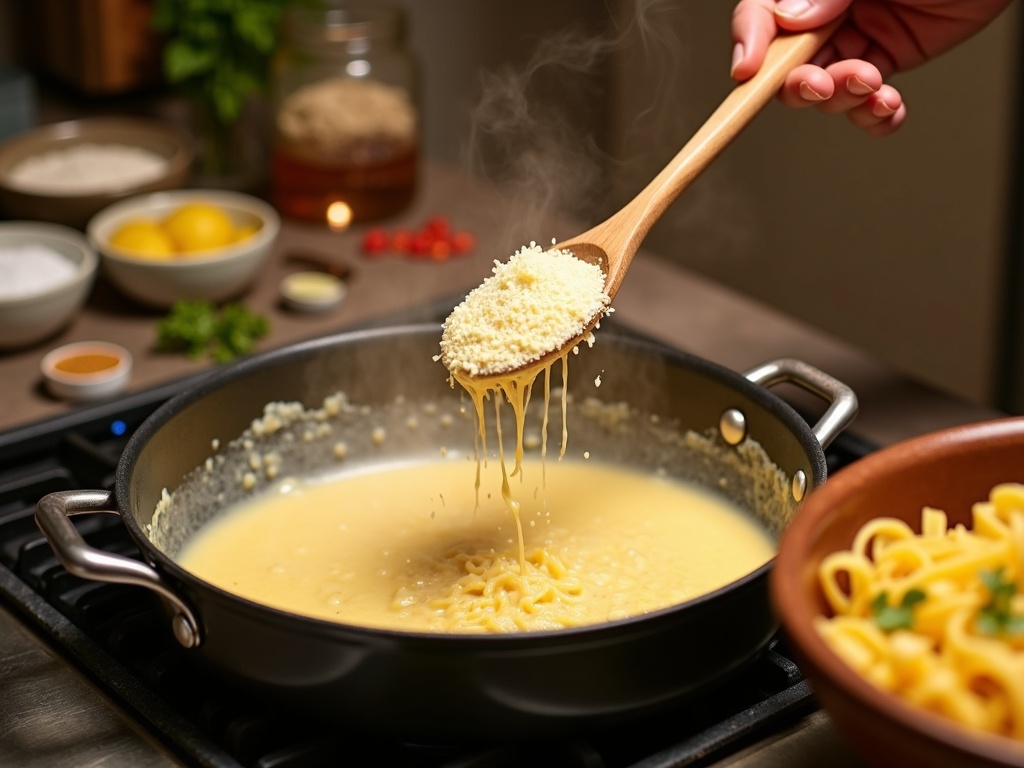
Putting It All Together
Once I’ve prepared the perfect white sauce, it’s time to marry it with pasta for that creamy, comforting dish everyone loves. The final assembly stage is where all the flavors come together, transforming simple ingredients into a restaurant-worthy meal.
The Assembly Process
First, I cook the pasta according to package instructions until it reaches that perfect al dente texture — tender but with a slight bite. Different pasta shapes require varying cooking times, so I always set a timer for the minimum suggested time and test from there. For white sauce pasta, shapes like fettuccine, penne, or farfalle work exceptionally well as they hold the creamy sauce beautifully.
When draining the pasta, I make sure to reserve about 1 cup of the starchy pasta water. This cloudy liquid is actually a secret weapon in Italian cooking — it contains starches that help the sauce cling to the pasta and adjust consistency as needed.
Next comes the crucial step — combining the pasta with the white sauce. I typically return the drained pasta to the pot (off the heat) and pour the warm sauce over it. Using tongs or a wooden spoon, I gently toss everything together until each strand or piece is evenly coated. This is where patience pays off — thorough mixing ensures every bite delivers that perfect sauce-to-pasta ratio.
If the sauce looks too thick at this point, I add a splash of the reserved pasta water and mix again. The starchy water helps thin the sauce while maintaining its creamy texture better than plain water would. I add just a little at a time until I reach the desired consistency — the sauce should coat the pasta well without pooling at the bottom of the dish.
For the finishing touches, I sprinkle fresh chopped parsley over the top for color and a bright flavor contrast. A generous dusting of additional grated Parmesan or Pecorino Romano cheese adds that final layer of flavor and visual appeal. For an extra special touch, I sometimes add a light crack of fresh black pepper or even a small drizzle of high-quality olive oil.
Final Tips to Perfect Your White Sauce Pasta
- Serve immediately while hot — the sauce will thicken as it cools
- Warm your serving bowls or plates for a restaurant-quality presentation
- If making ahead, prepare the sauce and pasta separately, then combine just before serving
- For protein additions, grilled chicken, sautéed shrimp, or crispy bacon bits can be folded in during the final mixing
- Consider a side of garlic bread to soak up any extra sauce on your plate
The beauty of this pasta dish lies in its versatility — once you’ve mastered the basic technique, you can customize it countless ways with different herbs, cheeses, or add-ins. The creamy white sauce creates a perfect canvas for whatever flavors you want to highlight.
Remember that timing is essential — pasta waits for no one, so have all components ready before combining. With these steps mastered, I can create a satisfying white sauce pasta that rivals any restaurant version, perfect for everything from quick weeknight dinners to impressive entertaining.
Common Mistakes to Avoid
Making a delicious white sauce pasta seems straightforward, but small mistakes can ruin your dish. I’ve encountered many kitchen disasters while perfecting my creamy Italian pasta recipes, and I’m sharing these tips so you can avoid the same pitfalls.
Critical Errors That Spoil Your White Sauce Pasta
Forgetting to salt your pasta water is possibly the most common mistake. Pasta needs properly salted water to develop flavor from within. The water should taste like the sea – about 1-2 tablespoons of salt per 4 quarts of water is perfect. Unsalted pasta tastes flat and can’t be fixed with sauce alone.
Adding cold milk directly to a hot roux creates lumps that are nearly impossible to fix. I always warm my milk slightly before slowly adding it to the flour and butter mixture, whisking constantly. This simple step makes a dramatic difference in creating a silky-smooth sauce without frustrating lumps.
Overcooking pasta is a texture disaster. White sauce pasta works best with pasta cooked al dente – firm to the bite. Remember that the pasta continues cooking slightly when mixed with the hot sauce, so I always stop cooking it about a minute before the package directions suggest. This ensures the final dish maintains that perfect texture rather than turning mushy.
Pre-grated cheese might save time, but it contains anti-caking agents that prevent proper melting. These additives create a grainy sauce instead of the velvety texture we’re aiming for. I always take the extra minute to grate cheese fresh for my pasta side dishes – the difference in taste and texture is remarkable.
Rushing the sauce thickening process leads to disappointment. White sauce needs time to develop properly:
- Cooking the roux for at least 2 minutes eliminates the raw flour taste
- Adding liquid gradually prevents lumps from forming
- Simmering for 5-7 minutes allows the sauce to reach the right consistency
- Stirring occasionally prevents scorching on the bottom
Patience during this process creates a thick, creamy sauce that clings beautifully to pasta. If you rush, you’ll likely end up with a sauce that’s either too thin or unevenly thickened.
Another mistake is overcrowding the pan when cooking mushrooms or other additions for your sauce. When ingredients are packed too tightly, they steam rather than sauté, resulting in soggy rather than caramelized vegetables. I always cook mushrooms in batches if needed to ensure they brown properly before adding them to my rich stock-based white sauce.
Seasoning only at the end limits flavor development. I layer seasonings throughout cooking:
- A pinch of salt in the roux
- Fresh herbs added in stages
- A final taste adjustment before serving
This ensures depth of flavor that permeates the entire dish.
Failing to warm serving plates means your perfect pasta cools too quickly. White sauce pasta sets up rapidly as it cools, so I always warm plates in the oven for a few minutes before serving to maintain that creamy consistency until the last bite.
The final mistake is skipping the taste test. White sauce needs careful seasoning, as the dairy components can mute flavors. I always taste before serving and add small adjustments of salt, pepper, or a squeeze of lemon juice to brighten the flavors if needed.
By avoiding these common pitfalls, your white sauce pasta will turn out restaurant-quality every time – creamy, flavorful, and perfectly balanced.
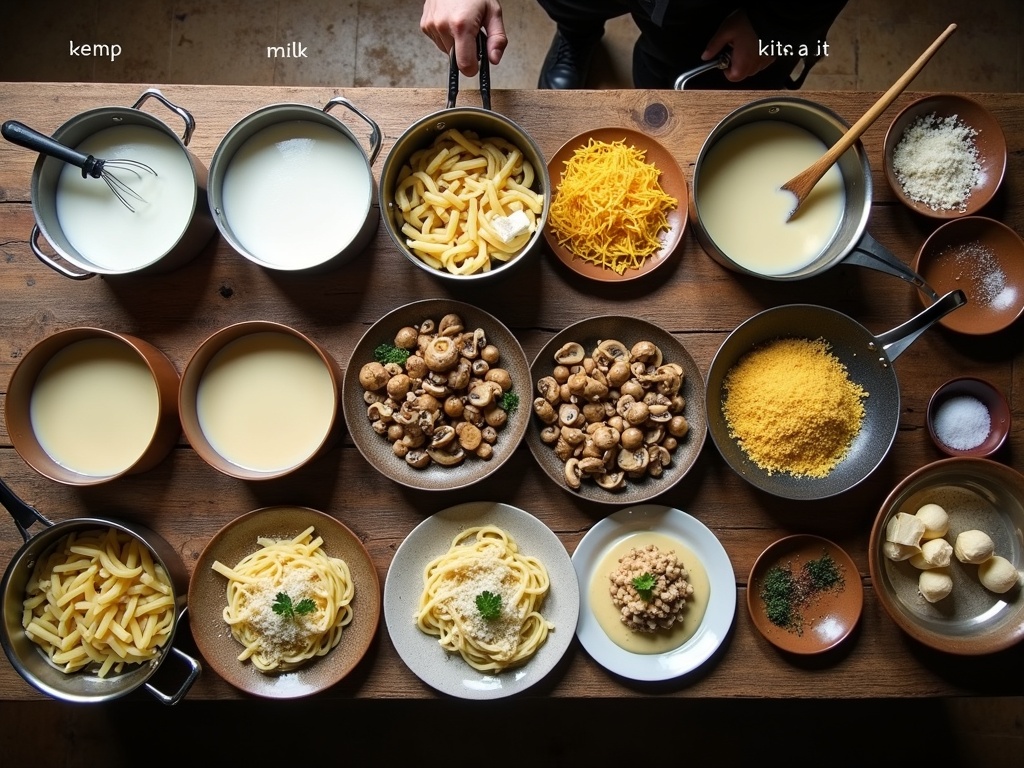
Pro Tips for the Perfect White Sauce
Making a flawless white sauce (béchamel) is often what separates an ordinary pasta dish from an extraordinary one. I’ve spent years perfecting this fundamental sauce, and I’ve gathered some game-changing tips that will elevate your white sauce pasta dishes to restaurant quality.
Mastering the Base Technique
Always use room temperature milk when making white sauce. Cold milk hitting a hot roux creates an immediate temperature shock that almost guarantees lumps. I take my milk out of the refrigerator at least 30 minutes before starting, or warm it slightly in the microwave if I’m short on time.
Continuous whisking isn’t just suggested—it’s essential. The moment you combine your flour and butter to create a roux, start whisking and don’t stop until your sauce is smooth and thickened. I use a balloon whisk for the best results as it incorporates air and breaks up potential lumps efficiently.
The raw flour taste can ruin an otherwise perfect sauce. I cook my roux for at least 2-3 minutes before adding milk, which develops a subtle nutty flavor instead of that pasty, uncooked taste. The roux should bubble gently and turn slightly golden—this small step makes a massive difference in the final flavor profile of your pasta dish.
Flavor Enhancement Strategies
Pre-packaged, pre-grated cheese contains anti-caking agents that can prevent proper melting and integration into your sauce. I always opt for freshly grated cheese, whether it’s Parmesan, Gruyère, or a sharp cheddar. The difference in meltability and flavor is remarkable—plus, grating cheese yourself typically costs less than buying it pre-grated.
Seasoning properly transforms a decent white sauce into an exceptional one. Here are my must-follow seasoning guidelines:
- Add salt gradually and taste frequently—remember that cheese adds saltiness too
- Freshly cracked black pepper provides better flavor than pre-ground
- A pinch of nutmeg complements the creamy richness perfectly
- For added complexity, try a small amount of white pepper or a bay leaf during cooking
- Garlic powder (not garlic salt) can add depth without overwhelming the sauce
When adding cheese, remove the sauce from heat first. The residual heat will melt the cheese without risking separation that can occur at higher temperatures. This approach creates that silky, smooth texture that clings perfectly to pasta rather than breaking into an oily mess.
If your sauce seems too thick, don’t automatically reach for more milk. I find that a splash of the starchy pasta cooking water often provides the perfect consistency adjustment while helping the sauce adhere to the pasta better.
For a truly professional touch, I sometimes infuse my milk with aromatics before making the sauce. Simply warm the milk with a bay leaf, clove-studded onion half, or a sprig of thyme, then strain before using. This subtle background flavor creates a sauce with remarkable depth.
The perfect white sauce pasta begins with patience. I never rush the process by turning up the heat—a gentle simmer allows the sauce to gradually thicken without scorching. Remember that the sauce will continue to thicken slightly as it cools, so I typically aim for a consistency just slightly thinner than desired for the final dish.
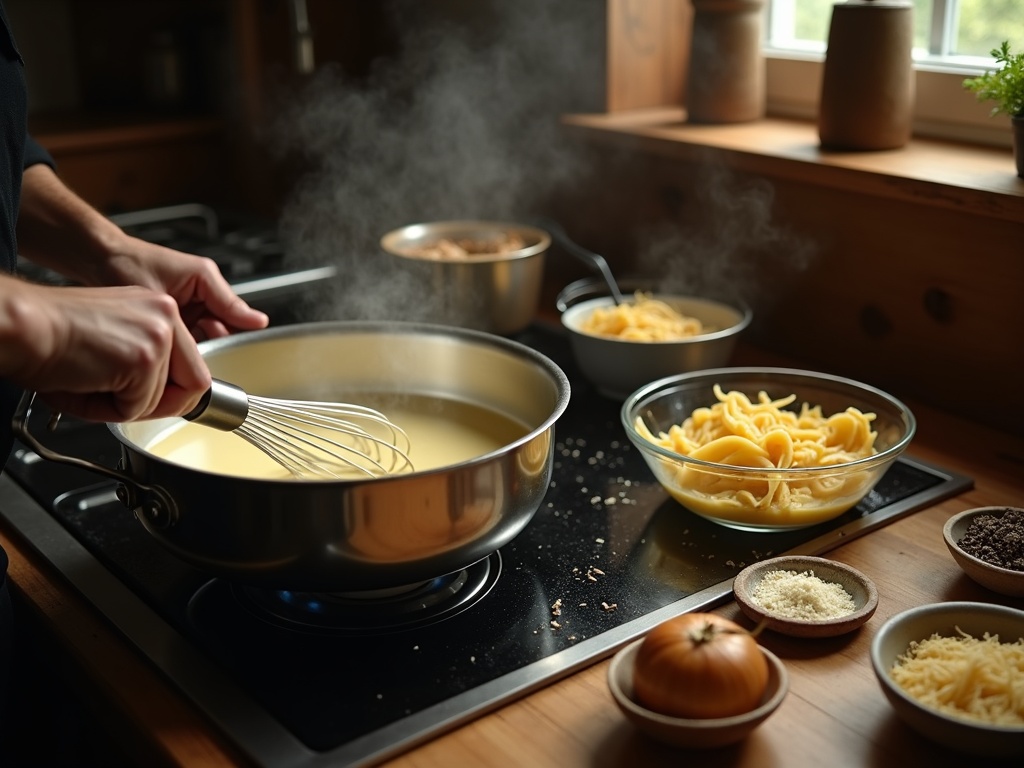
Storage and Reheating Guide
Properly storing and reheating white sauce pasta can make the difference between enjoying delicious leftovers and ending up with a disappointing, congealed mess. I’ve found that white sauce-based dishes require special attention since the creamy sauce tends to separate or thicken when cooled.
Proper Storage Techniques
After cooking your white sauce pasta dish, allow it to cool completely before transferring it to storage. Heat accelerates bacterial growth, so I never leave my pasta sitting at room temperature for more than two hours. Once cooled, transfer the pasta to an airtight container – this prevents it from absorbing other odors in your refrigerator and maintains its moisture level.
When stored correctly, white sauce pasta keeps fresh for 3-4 days in the refrigerator. The airtight seal is crucial because the cream-based sauce can easily absorb nearby food aromas, affecting its delicate flavor profile. I’ve noticed that glass containers work particularly well for storing creamy pasta dishes, as they don’t retain odors like some plastic containers might.
For best quality, consume your stored pasta within the first two days. While it remains safe to eat for up to 4 days, the texture and flavor are at their peak during those initial 48 hours. The sauce gradually breaks down over time, affecting both consistency and taste.
If you’ve made a large batch of pasta with white sauce, consider dividing it into smaller portions before refrigerating. This approach allows you to reheat only what you need, preserving the quality of the remaining pasta for future meals.
Reheating Tips
When it comes to reheating, the process requires careful attention to revive your dish to its former glory. Here are the steps I follow for perfect reheated white sauce pasta:
- Add a splash of milk (about 1–2 tablespoons per cup of pasta) to the container before reheating
- Warm slowly over medium-low heat if using a stovetop
- Stir gently but frequently to prevent the sauce from breaking
- Heat just until warmed through – overheating will cause the sauce to separate
- For microwave reheating, use medium power in 30-second intervals, stirring between each
The added milk is the secret ingredient when reheating. It helps restore the creamy consistency that makes white sauce pasta so delicious in the first place. Without it, the sauce often becomes thick and gluey after refrigeration.
I’ve found that gentle stirring while warming is essential. This helps distribute the heat evenly and prevents the sauce from sticking to the bottom of the pan. Too vigorous stirring can break down the pasta, turning your dish mushy.
If you notice the sauce still appears too thick after adding milk, don’t hesitate to add a bit more until you reach your desired consistency. The goal is to recreate the silky texture of freshly made white sauce pasta.
For busy weeknights, I sometimes prepare a double batch of white sauce separately and store it apart from cooked pasta. This approach gives me more flexibility, as I can quickly cook fresh pasta and reheat just the amount of sauce needed for each meal.
With these storage and reheating techniques, you’ll be able to enjoy your white sauce pasta creations for days after cooking, with minimal loss of flavor and texture.

